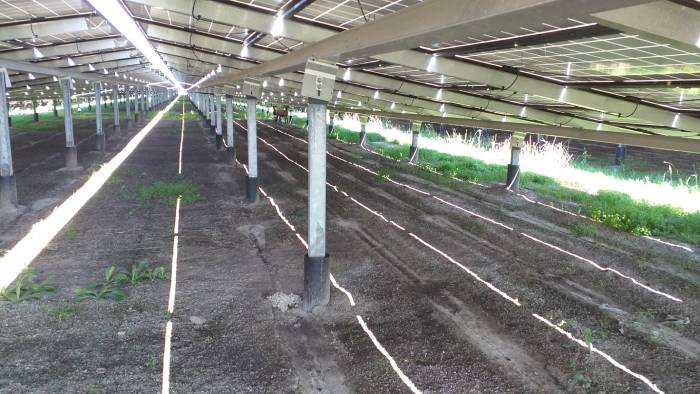From pv magazine International
The Netherlands Organization for Applied Scientific Research (TNO) has designed a new approach for building east-west-oriented solar parks which it claims can prevent soil deterioration and offer the same yield as south-oriented PV plants.
In a dedicated study, the Dutch scientists explained that, although east-west solar parks are becoming increasingly popular in the Netherlands where land constraints and high land costs are pushing developers to build solar plants with a highly packed panel density, these installations present a challenge for the soil, because they are placed so closely together and cover almost all the ground beneath, thus reducing the light reaching it over a 25-year period or more.
According to the researchers, industry-standard east-west solar parks built in the country have a ground coverage ratio of over 90%, which is highly detrimental for the soil beneath the panels. “It will then take a great deal of time and effort to restore the soil quality that existed before the solar farm was constructed,” the TNO scientists said.
To combat this, the researchers have developed two variants of their novel design. The first sees module arrays built in portrait orientation that are eight meters long, feature a large gap between the arrays, and have a ground coverage ratio of around 77%. “Clearly the irradiance below the bottom gap between an east– and a west–facing module is very high but it also allows more light in the immediate region below those modules,” the academics said. “Also the larger top gap allows more light and distributes that light over a fairly large region.”
In the second variant, which has the same ground coverage ratio as the first, the scientists halved the height of the module arrays and the size of the gaps and, at the same time, utilized semi-transparent bifacial modules. “A 77% coverage design with semi-transparent, bifacial panels scores better in terms of the effect on soil quality than south-facing standard panels with 53% coverage. As a result, almost 100% of the soil receives sufficient sunlight at a higher degree of coverage,” they further explained.
The TNO said this new research is in line with another study published earlier this year by the Netherlands’ Wageningen University & Research, on the effects of solar parks on biodiversity. “The ‘educated guess’ of the project partners is that well-designed, operated, and maintained solar parks can have a positive impact compared to well-defined reference situations, and especially compared to intensive agricultural monoculture use,” Wim Sinke, principal scientist for solar energy at the energy transition unit of TNO, told pv magazine in May 2021.
This content is protected by copyright and may not be reused. If you want to cooperate with us and would like to reuse some of our content, please contact: editors@pv-magazine.com.









By submitting this form you agree to pv magazine using your data for the purposes of publishing your comment.
Your personal data will only be disclosed or otherwise transmitted to third parties for the purposes of spam filtering or if this is necessary for technical maintenance of the website. Any other transfer to third parties will not take place unless this is justified on the basis of applicable data protection regulations or if pv magazine is legally obliged to do so.
You may revoke this consent at any time with effect for the future, in which case your personal data will be deleted immediately. Otherwise, your data will be deleted if pv magazine has processed your request or the purpose of data storage is fulfilled.
Further information on data privacy can be found in our Data Protection Policy.